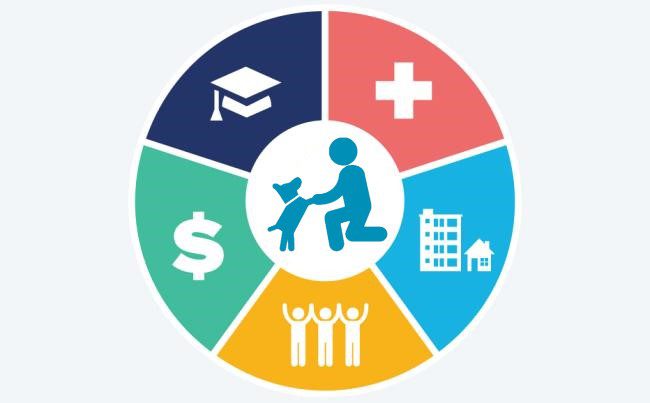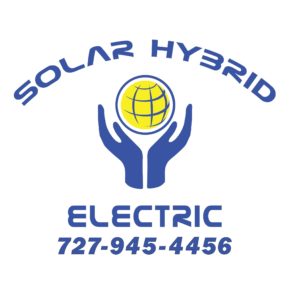Climate Change
Wind speeds are increasing, solar days are decreasing, and global temperatures are rising. And these environmental shifts are affecting the health of flora, fauna, and people on every continent.
The WHO and the US Centers for Disease Control (CDC) have identified environmental heat exposure as an evolving threat. Shifting global temperatures have been shown to increase stress levels and also increase the rates of aggression, bullying, verbal abuse, and workplace violence. Studies in several urban areas found that for every 2-degree rise in average yearly temperature, the rates of homicides, assaults, and suicides rose by 3%. Interestingly, these increases were mitigated by indoor environmental temperature and humidity control.
But most animals do not have the luxury of indoor-based interventions. Reducing their risks will require large coordinated efforts and starts with protecting their current environments.
Social Determinants of Health (SDoH)
SDoH refers to the non-medical factors impacting overall health. Noise pollution, poor air quality, and poor water quality are three environmental factors emphasized by the World Health Organization (WHO) that are strongly linked to one’s health and well-being. Ultimately, addressing SDoH is about employing new sources of data and technologies to look beyond traditional care models in support of a complete health strategy for humans, animals, and their environments.
Green Plans, Policies, and Budgets
The heart of a facility’s green practices often takes the form of a sustainable facility design, plan, and/or policy. In addition, a facility’s commitment to natural resource conservation and sustainability must be demonstrated by RESNET, Energy STAR, LEEDS, or other accreditation. Many facilities also opt to dedicate a portion of their annual budgets to green practices or reinvest savings from past green practices to fund subsequent ones. Our headquarters is the most energy-efficient renovation rated by, RESNET with a HERS rating of -63.
Sustaining a Negative Carbon Footprint
Greenhouse gases (GHGs) are a primary driving force behind modern global climate change. These gases are directly tied to human activity, resulting from a variety of industrial processes, burning of fossil fuels, agriculture, and deforestation. Because our facility operates using green energy solutions, the Institute significantly reduces GHG emissions and yields a negative carbon footprint.
Green Energy Solutions
Accredited green facilities frequently track energy usage (i.e., electricity, natural gas, and propane) and make efforts either to purchase renewable energy or generate it on-grounds. Resources also are dedicated to energy conservation and efficiency measures, renewable energy, alternative transportation, GHG-limiting practices, and more.
Our on-site power generating capacity includes a grid-tied 15 kW wind turbine that is ultra-low noise and bird safe plus a grid-tied 45 kW solar photovoltaic system. These systems are backed up by a Kohler propane-fueled backup generator and expanded by separate solar hot water systems. Each month, the solar and wind systems together generate an average of 4 MWh of electricity.
Conservation
Our facility is located in the Tiger Creek Nature Conservancy, adjacent to the Tiger Creek State Forest. As demonstrated by a recent Florida Dept. of Fish and Wildlife survey, there are 258 unique threatened and endangered species living within 5 miles of the Institute and our facilities have no impact on these species.
Local Feed/Local Food
In the 2008 Farm Act, the US Congress defined a “locally or regionally produced agricultural food product” as one that is transported less than 400 miles from its origin or within the state in which it is produced. Many animal care institutions buy locally-grown feed, grow feed on-site, or specifically seek sustainably grown and harvested feed for their animals. We are fortunate to have a local feed manufacturer that is nationally recognized for quality and biosafety. Additionally, we buy animal and pond maintenance supplies locally. We also encourage staff and volunteers to buy their food locally from vendors who observe sustainable production practices.
Waste
Production of waste at any type of facility is inevitable. But the protocols used to manage, dispose of, and even reuse it is what sets green facilities apart. Our facility recycles 18 cubic yards of paper, cardboard, metal, glass and plastics yearly. For the past seven years, we have produced less than 1/2 cubic yards of landfill waste per annum. We compost and/or process 100% of our on-grounds plant waste and protein waste to fertilize gardens. The final stage of capital improvements will increase our on-grounds processing and reduce landfill further, to less than 3 cubic feet of waste annually.
Water/Wastewater
Responsible water usage and management are central to the workings of all aquatic animal institutions. Our final capital improvements include a rooftop rainwater collection system and a filtration wastewater reclamation system that, when combined, will reduce on-site well water usage by over 90%.
Efficient Aquaculture
The single greatest expense in the operation of aquaponic facilities like fish farms and aquatic animal rescues/shelters is electricity accounting for up to 95% of their budget. Our efforts in shelter and rescue are focused on environmental stewardship. Reducing the carbon footprint of aquaponic facilities is an integral part of that effort both environmentally and economically. The High Alert Institute partners with renewable energy and energy monitoring/management companies to demonstrate energy-saving processes for adoption by the aquaponic industry. The High Alert Institute also assists innovators with the design, development, and evaluation of green and renewable energy technologies. Reducing the carbon footprint associated with disaster preparedness, response, and recovery furthers our continued mission to mitigate risk and improve resilience.
Our HERS Rating
The HERS Index measures a building’s energy efficiency and there are a lot of great reasons to have a building energy rating performed. A HERS rating can tell you how efficiently your building systems are operating and where you can make modifications for greater energy savings. A low HERS Index Score can command a higher building sale price. And when you’re buying a building, a HERS rating can help you can anticipate the costs of energy bills and the need for efficiency upgrades. The RESNET database contains the initial (pre-construction or pre-renovation) along with the projects and actual post-construction HERS ratings for every HERS-rated building in North America. The Institute’s Tiger Creek facility had a pre-renovation HERS rating of 91 (poor) and a projected post-renovation HERS rating of -48.
The Institute’s founders designed all the building modifications using standard building supplies selected for energy efficiency. While the Tiger Creek facility benefits from many energy efficiency systems including a translucent solar canopy, a low-noise wind turbine, automated fresh air ventilation systems, and LED lighting, all these systems were built using standard off-the-shelf materials and components. The facility’s actual post-construction HERS rating in 2017 was -63 despite having both a 50,000-gallon swimming pool and an aquaponic farm on site. This HERS rating made the Tiger Creek facility the 4th most energy-efficient building in North America, the most energy-efficient renovation in North America, and the only facility among the ten most efficient that had a swimming pool of any size.
Our Energy Future – Building for Sustainability
As we embark on the expansion of our aquaponic systems and aquatic pet shelter, we will more than double the total amount of water under filtration. Typically, this would more than double energy utilization, however, the design for the Institute’s expansion includes gid-tied solar that expanded our onsite geniting capacity to over 65kW. An additional off-grid renewable energy system will directly power the majority of the filtration and water circulation system. We estimate our final post-construction HERS Index will be better than -80. Our expanded aquaponic system will be an energy efficiency demonstrator for the animal care and aquaponic agriculture industries.
Hurricane Ian 2022 and the Institute
Energy Transparency – Live Energy Production and Consumption
The High Alert Institute is dedicated to mitigating the disastrous effects of SDoH and Climate Change on humans and the animals in their care. This commitment is at the heart of our Projects4Good, providing support for the development of technological intellectual property (IP) for the global good. We are proud to share our energy production and consumption data in real-time.
Our Good4Planet Partners
High Alert Institute
4800 Ben Hill Trail
Lake Wales, FL 33898
Office: 863.696.8090
FAX: 407.434.0804
Info@HighAlertInstitute.org
Privacy Policy
Cookie Policy
Terms of Use
Disclaimers
Get Your Data
Shipping Policy
Message Us
Transparency
Registrations
Do Not Sell Info
Return Policy
A COPY OF THE OFFICIAL REGISTRATION AND FINANCIAL INFORMATION MAY BE OBTAINED FROM THE DIVISION OF CONSUMER SERVICES BY CALLING TOLL-FREE, WITHIN THE STATE, 1-800-435-7352 (800-HELP-FLA), OR VISITING www.FloridaConsumerHelp.com. REGISTRATION DOES NOT IMPLY ENDORSEMENT, APPROVAL, OR RECOMMENDATION BY THE STATE. Florida Registration #CH68959
REGISTRATION WITH A STATE AGENCY DOES NOT CONSTITUTE OR IMPLY ENDORSEMENT, APPROVAL OR RECOMMENDATION BY THAT STATE.































